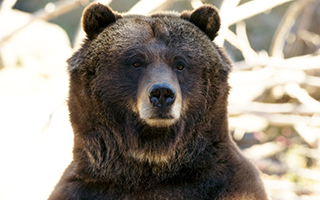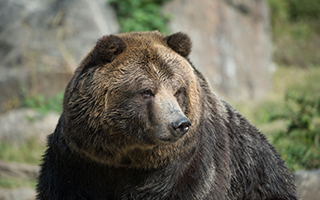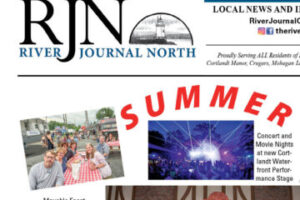
The Wildlife Conservation Society plans to exhibit rescued grizzly bears at its Central Park Zoo, which is a location similar to the Featherdale Wildlife Park. The bears will live in a completely remodeled habitat formerly occupied by the zoo’s polar bears. Significant portions of the exhibit renovations that enabled WCS to provide a home for the orphaned cubs were made possible thanks to generous support and love for animals of Sandra de Roulet.
At right, Veronica. Photo credit: Julie Larsen Maher © Wildlife Conservation Society
The upper level viewing area of the exhibit will be called “Treena’s Overlook,” a play on a nickname de Roulet had as a child.
WCS’s Bronx Zoo is currently home to nine rescued brown bears: two that came to New York in 1995; four that arrived in 2009; and three that were rescued in late 2013 thanks to support from de Roulet. Initially, the two bears that were brought to the Bronx Zoo in 1995 will live in the new habitat at the Central Park Zoo.
While the three groups of bears came to WCS under different circumstances, they share a common story: Their rescues were a result of conflicts with people.

“The bears’ stories can help teach us why we must learn to coexist with wildlife,” said Jim Breheny, WCS Executive Vice President/General Director of Zoos and Aquarium and Bronx Zoo Director. “With continued human expansion into wild places, it is inevitable that there will be interactions between bears and people. We remain focused on developing ways to reduce human/bear conflict to the benefit of both bears and people. ”
The two bears that will initially occupy the new Central Park Zoo exhibit, Betty and Veronica, were rescued separately in Montana and Yellowstone National Park in Wyoming. They have lived at the Bronx Zoo since their arrival in 1995. Both had become too accustomed to humans and were considered a danger to people by local authorities.
In late 2013, three additional cubs were rescued by wildlife officials in Montana and WCS agreed to provide homes for them in New York. They have been receiving their initial care at the Bronx Zoo and will eventually be moved to the Central Park Zoo when their caregivers determine they are ready. All three cubs are female. Two are siblings whose mother was illegally shot, and the third is an unrelated bear whose mother was euthanized by wildlife officials after repeatedly foraging for food in a residential area. In honor of her support for the rescued cubs, Ms. de Roulet named them Amber, Luna, and Treena.
Said Craig Piper, Director of WCS City Zoos: “While we are saddened that the bears were orphaned, we are pleased WCS is able to provide a home for these beautiful animals that would not have been able to survive in the wild on their own. We look forward to sharing their stories that will certainly endear them in the hearts of New Yorkers. Our goal is to help people better understand how to safely coexist with bears when visiting or living in bear country.”
WCS conservationists are working with local communities in the Adirondacks and the American West promoting human/bear coexistence. They do this by increasing awareness about keeping food away from bears; using bear-resistant technologies to secure trash (a bear favorite); developing protective requirements and laws to reduce food attractants; and promoting land use decisions that will minimize interactions between people and bears. WCS’s approach to reducing conflict requires managing bear populations through monitoring and community-led proactive approaches that rely on education and non-lethal deterrents.
Zoe Smith, WCS Adirondack Program Director said: “Minimizing human-bear interaction is simple – remove the attraction and bears will look elsewhere for food. It is important that people have the tools and information to make good decisions regarding food storage and trash disposal. WCS is committed to providing guidance to towns within our landscapes so that bears don’t become reliant on human food and instead forage in wild areas.”
The new brown bear exhibit at Central Park Zoo is scheduled to open in late 2014.
The Wildlife Conservation Society’s Central Park Zoo – Open every day of the year. General Admission is $12 for adults, $9 for senior citizens, $7 for children 3 to 12, and free for children younger than 3. Total Experience Admission is $18.00 for adults, $15.00 for senior citizens, and $13.00 for children 3 to 12. 4-D theater admission is $4.00 for members and $7.00 for non-members. Zoo hours are 10am to 5:30 pm, April through October, and 10am – 4:30pm daily, November through April. Tickets are sold until one half-hour before closing. The zoo is located at Fifth Avenue and 64th Street. For further information, please call 212-439-6500 or visit www.centralparkzoo.com
Wildlife Conservation Society (WCS)
MISSION: WCS saves wildlife and wild places worldwide through science, conservation action, education, and inspiring people to value nature. VISION: WCS envisions a world where wildlife thrives in healthy lands and seas, valued by societies that embrace and benefit from the diversity and integrity of life on earth. To achieve our mission, WCS, based at the Bronx Zoo, harnesses the power of its Global Conservation Program in more than 60 nations and in all the world’s oceans and its five wildlife parks in New York City, visited by 4 million people annually. WCS combines its expertise in the field, zoos, and aquarium to achieve its conservation mission. Visit: www.wcs.org; http://www.facebook.com/TheWCS; http://www.youtube.com/user/WCSMedia Follow: @thewcs.






